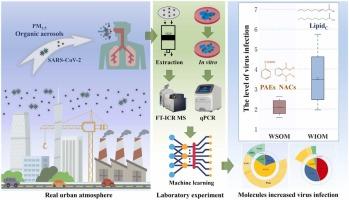Molecular characteristics of organic matters in PM2.5 associated with upregulation of respiratory virus infection in vitro
IF 12.2
1区 环境科学与生态学
Q1 ENGINEERING, ENVIRONMENTAL
引用次数: 0
Abstract
The extent to which organic matters (OM) in PM2.5 affect virus infections and the key organic molecules involved in this process remain unclear. Herein, this study utilized ultra-high resolution mass spectrometry coupled with in vitro experiments to identify the organic molecules associated with respiratory virus infection for the first time. Water-soluble organic matters (WSOM) and water-insoluble organic matters (WIOM) were separated from PM2.5 samples collected at the urban area of Guangzhou, China. Their molecular compositions were analyzed using Fourier transform ion cyclotron resonance mass spectrometry. Subsequently, in vitro experiments were conducted to explore the impact of WSOM and WIOM exposure on the severe acute respiratory syndrome coronavirus 2 (SARS-CoV-2) pseudo-virus infection in A549 cells. Results revealed that WSOM and WIOM respectively promoted 1.7 to 2.1-fold and 1.9 to 3.5-fold upregulation of SARS-CoV-2 pseudo-virus infection in a concentration-dependent manner (at 25 to 100 μg mL−1) compared to the virus-only control group. Partial least squares model analysis indicated that the increased virus infection was likely related to phthalate ester and nitro-aromatic molecules in WSOM, as well as LipidC molecules with aliphatic and olefinic structures in WIOM. Interestingly, the molecules responsible for upregulating SARS-CoV-2 receptor angiotensin-converting enzyme 2 (ACE2) expression and virus infection differed. Thus, it was concluded that ACE2 upregulation alone may not fully elucidate the mechanisms underlying increased susceptibility to virus infection. The findings highlight the critical importance of aromatic and lipid molecules found in OM in relation to respiratory virus infection.

PM2.5 中有机物的分子特征与体外呼吸道病毒感染的上调有关
PM2.5 中的有机物(OM)对病毒感染的影响程度以及参与这一过程的关键有机分子仍不清楚。本研究利用超高分辨率质谱法结合体外实验,首次确定了与呼吸道病毒感染相关的有机分子。研究人员从广州城区采集的 PM2.5 样品中分离出水溶性有机物(WSOM)和水不溶性有机物(WIOM)。利用傅立叶变换离子回旋共振质谱分析了它们的分子组成。随后,通过体外实验探讨了WSOM和WIOM暴露对A549细胞感染严重急性呼吸系统综合征冠状病毒2(SARS-CoV-2)伪病毒的影响。结果显示,与纯病毒对照组相比,WSOM和WIOM分别以浓度依赖的方式(25至100 μg mL-1)促进SARS-CoV-2伪病毒感染上调1.7至2.1倍和1.9至3.5倍。偏最小二乘法模型分析表明,病毒感染增加可能与 WSOM 中的邻苯二甲酸酯和硝基芳香族分子以及 WIOM 中具有脂肪族和烯烃结构的 LipidC 分子有关。有趣的是,上调 SARS-CoV-2 受体血管紧张素转换酶 2(ACE2)表达的分子与病毒感染不同。因此,结论是仅靠 ACE2 上调可能无法完全阐明病毒感染易感性增加的机制。研究结果突出表明,OM 中的芳香分子和脂质分子对呼吸道病毒感染至关重要。
本文章由计算机程序翻译,如有差异,请以英文原文为准。
求助全文
约1分钟内获得全文
求助全文
来源期刊

Journal of Hazardous Materials
工程技术-工程:环境
CiteScore
25.40
自引率
5.90%
发文量
3059
审稿时长
58 days
期刊介绍:
The Journal of Hazardous Materials serves as a global platform for promoting cutting-edge research in the field of Environmental Science and Engineering. Our publication features a wide range of articles, including full-length research papers, review articles, and perspectives, with the aim of enhancing our understanding of the dangers and risks associated with various materials concerning public health and the environment. It is important to note that the term "environmental contaminants" refers specifically to substances that pose hazardous effects through contamination, while excluding those that do not have such impacts on the environment or human health. Moreover, we emphasize the distinction between wastes and hazardous materials in order to provide further clarity on the scope of the journal. We have a keen interest in exploring specific compounds and microbial agents that have adverse effects on the environment.
 求助内容:
求助内容: 应助结果提醒方式:
应助结果提醒方式:


